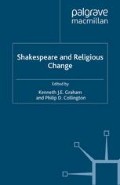Abstract
In their book, The Queen’s Men and their Plays, Scott McMillin and Sally-Beth MacLean suggest a number of reasons why Elizabeth I formed a new theater company in 1583. Beyond centralizing control of the burgeoning theater industry at court, the queen and Privy Council’s agenda included ‘unifying the country’ by ‘spreading a court-inspired culture,’ not only carrying ‘the name and influence of the monarch through the country’ but also giving ‘the impression of a watchful monarch, one whose “men” ranged over the land.’ A key political concern of the government ‘centred on the religious arguments of the day, issues imbued with dangers from the old faith and problems from the new’, as Alexandra Johnston also demonstrated in the previous chapter.1 Viewed from the perspective painted by Patrick Collinson, Elizabeth I, with her insistence on moderate Protestant reform, anxiously presided as ‘a protestant paragon ... head of Christ’s Church on earth’ over ‘popish recusants’ and ‘church papists,’ on the one hand, and the godly, Calvinist-inspired ‘hot-gospellers’ or ‘Puritans,’ on the other.2
Access this chapter
Tax calculation will be finalised at checkout
Purchases are for personal use only
Preview
Unable to display preview. Download preview PDF.
Notes
Scott McMillin and Sally-Beth MacLean, The Queen’s Men and their Plays (Cambridge: Cambridge University Press, 1998), 26–8
Patrick Collinson, The Reformation (London: Weidenfeld and Nicolson, 2003), 116.
A preacher and headmaster at Norwich Free School, Lymbert is thought to have taught Robert Greene and to have worked with William Burton; H.W. Saunders, A History of the Norwich Grammar School (Norwich: Jarrold, 1932), 142
Susan Wabuda, Preaching during the English Reformation (Cambridge: Cambridge University Press, 2002), 65
Author information
Authors and Affiliations
Editor information
Editors and Affiliations
Copyright information
© 2009 Mary A. Blackstone
About this chapter
Cite this chapter
Blackstone, M.A. (2009). The Queen’s Men and the Performance of Allegiance, Conformity, and Difference in Elizabethan Norwich. In: Graham, K.J.E., Collington, P.D. (eds) Shakespeare and Religious Change. Early Modern Literature in History. Palgrave Macmillan, London. https://doi.org/10.1057/9780230240858_5
Download citation
DOI: https://doi.org/10.1057/9780230240858_5
Publisher Name: Palgrave Macmillan, London
Print ISBN: 978-1-349-30336-6
Online ISBN: 978-0-230-24085-8
eBook Packages: Palgrave Religion & Philosophy CollectionPhilosophy and Religion (R0)

